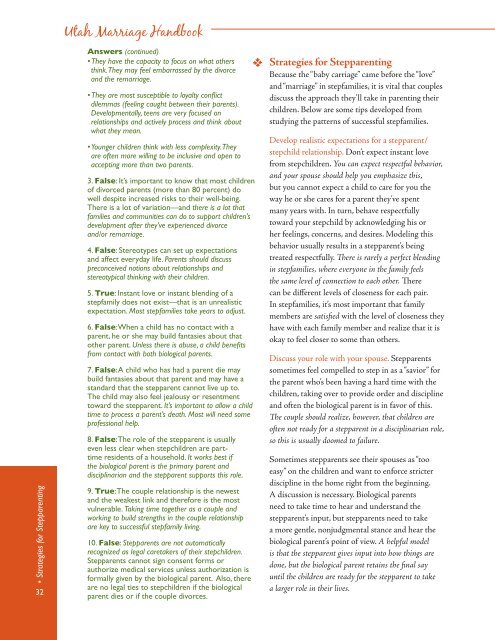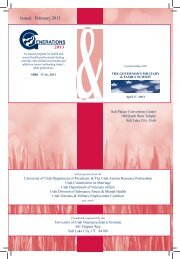The Utah Marriage Handbook - Stronger Marriage
The Utah Marriage Handbook - Stronger Marriage
The Utah Marriage Handbook - Stronger Marriage
Create successful ePaper yourself
Turn your PDF publications into a flip-book with our unique Google optimized e-Paper software.
• Strategies for Stepparenting<br />
32<br />
<strong>Utah</strong> <strong>Marriage</strong> <strong>Handbook</strong><br />
Answers (continued)<br />
• <strong>The</strong>y have the capacity to focus on what others<br />
think. <strong>The</strong>y may feel embarrassed by the divorce<br />
and the remarriage.<br />
• <strong>The</strong>y are most susceptible to loyalty conflict<br />
dilemmas (feeling caught between their parents).<br />
Developmentally, teens are very focused on<br />
relationships and actively process and think about<br />
what they mean.<br />
• Younger children think with less complexity. <strong>The</strong>y<br />
are often more willing to be inclusive and open to<br />
accepting more than two parents.<br />
3. False: It’s important to know that most children<br />
of divorced parents (more than 80 percent) do<br />
well despite increased risks to their well-being.<br />
<strong>The</strong>re is a lot of variation—and there is a lot that<br />
families and communities can do to support children’s<br />
development after they’ve experienced divorce<br />
and/or remarriage.<br />
4. False: Stereotypes can set up expectations<br />
and affect everyday life. Parents should discuss<br />
preconceived notions about relationships and<br />
stereotypical thinking with their children.<br />
5. True: Instant love or instant blending of a<br />
stepfamily does not exist—that is an unrealistic<br />
expectation. Most stepfamilies take years to adjust.<br />
6. False: When a child has no contact with a<br />
parent, he or she may build fantasies about that<br />
other parent. Unless there is abuse, a child benefits<br />
from contact with both biological parents.<br />
7. False: A child who has had a parent die may<br />
build fantasies about that parent and may have a<br />
standard that the stepparent cannot live up to.<br />
<strong>The</strong> child may also feel jealousy or resentment<br />
toward the stepparent. It’s important to allow a child<br />
time to process a parent’s death. Most will need some<br />
professional help.<br />
8. False: <strong>The</strong> role of the stepparent is usually<br />
even less clear when stepchildren are parttime<br />
residents of a household. It works best if<br />
the biological parent is the primary parent and<br />
disciplinarian and the stepparent supports this role.<br />
9. True: <strong>The</strong> couple relationship is the newest<br />
and the weakest link and therefore is the most<br />
vulnerable. Taking time together as a couple and<br />
working to build strengths in the couple relationship<br />
are key to successful stepfamily living.<br />
10. False: Stepparents are not automatically<br />
recognized as legal caretakers of their stepchildren.<br />
Stepparents cannot sign consent forms or<br />
authorize medical services unless authorization is<br />
formally given by the biological parent. Also, there<br />
are no legal ties to stepchildren if the biological<br />
parent dies or if the couple divorces.<br />
Strategies for Stepparenting<br />
Because the “baby carriage” came before the “love”<br />
and “marriage” in stepfamilies, it is vital that couples<br />
discuss the approach they’ll take in parenting their<br />
children. Below are some tips developed from<br />
studying the patterns of successful stepfamilies.<br />
Develop realistic expectations for a stepparent/<br />
stepchild relationship. Don’t expect instant love<br />
from stepchildren. You can expect respectful behavior,<br />
and your spouse should help you emphasize this,<br />
but you cannot expect a child to care for you the<br />
way he or she cares for a parent they’ve spent<br />
many years with. In turn, behave respectfully<br />
toward your stepchild by acknowledging his or<br />
her feelings, concerns, and desires. Modeling this<br />
behavior usually results in a stepparent’s being<br />
treated respectfully. <strong>The</strong>re is rarely a perfect blending<br />
in stepfamilies, where everyone in the family feels<br />
the same level of connection to each other. <strong>The</strong>re<br />
can be different levels of closeness for each pair.<br />
In stepfamilies, it’s most important that family<br />
members are satisfied with the level of closeness they<br />
have with each family member and realize that it is<br />
okay to feel closer to some than others.<br />
Discuss your role with your spouse. Stepparents<br />
sometimes feel compelled to step in as a “savior” for<br />
the parent who’s been having a hard time with the<br />
children, taking over to provide order and discipline<br />
and often the biological parent is in favor of this.<br />
<strong>The</strong> couple should realize, however, that children are<br />
often not ready for a stepparent in a disciplinarian role,<br />
so this is usually doomed to failure.<br />
Sometimes stepparents see their spouses as “too<br />
easy” on the children and want to enforce stricter<br />
discipline in the home right from the beginning.<br />
A discussion is necessary. Biological parents<br />
need to take time to hear and understand the<br />
stepparent’s input, but stepparents need to take<br />
a more gentle, nonjudgmental stance and hear the<br />
biological parent’s point of view. A helpful model<br />
is that the stepparent gives input into how things are<br />
done, but the biological parent retains the final say<br />
until the children are ready for the stepparent to take<br />
a larger role in their lives.




